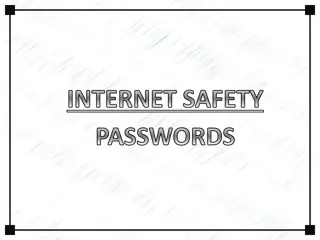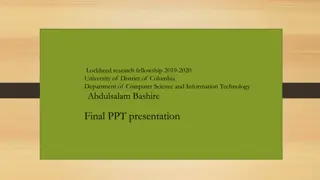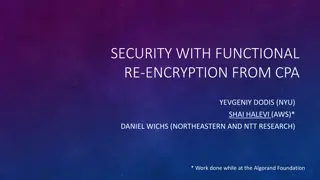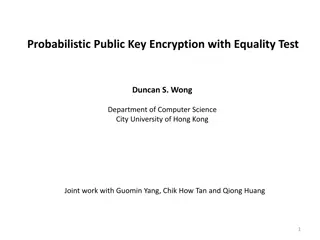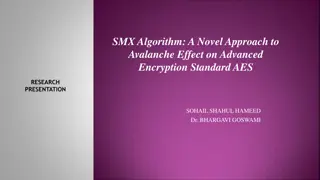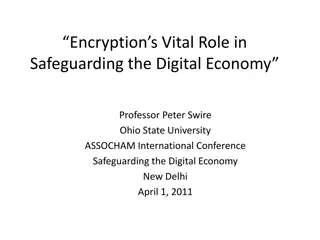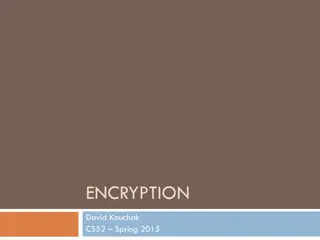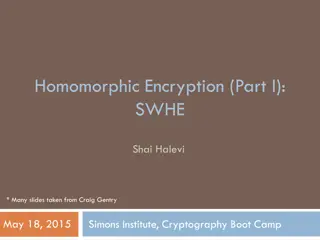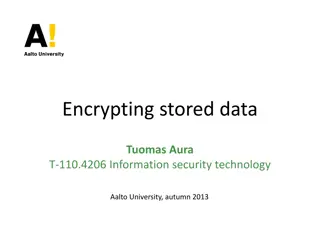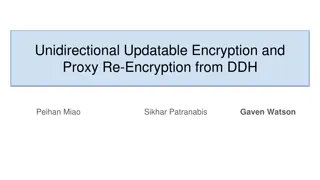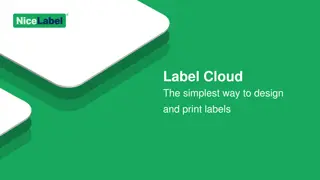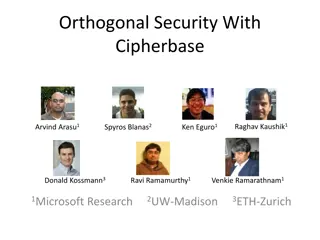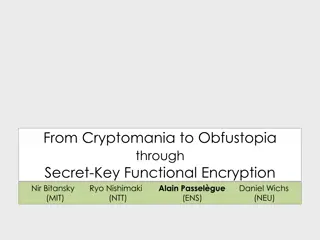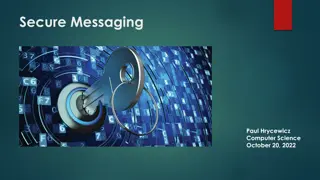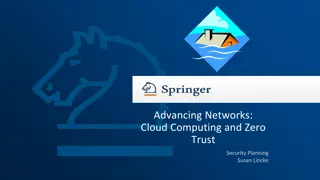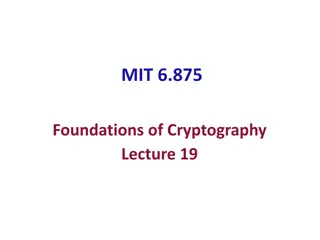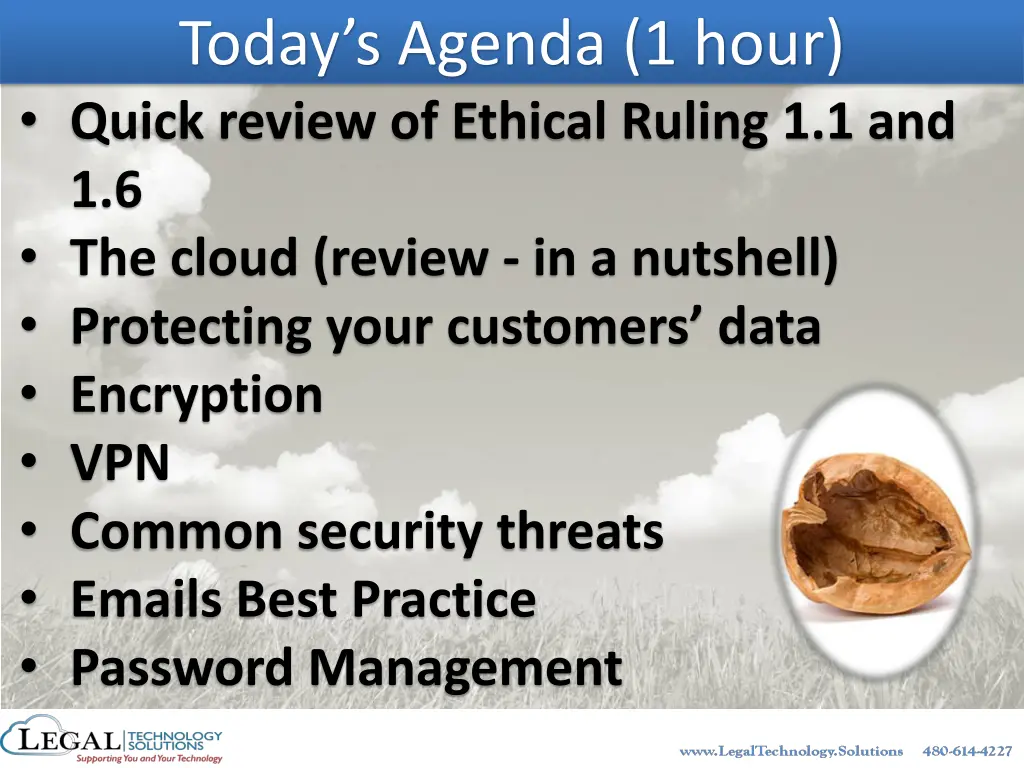
Quick Review of Ethical Ruling and Data Protection Best Practices
Explore the importance of ethical rulings 1.1 and 1.6 along with safeguarding customer data through encryption, VPN, and common security threats. Learn about the cloud, email security best practices, password management, and more in this concise agenda.
Download Presentation

Please find below an Image/Link to download the presentation.
The content on the website is provided AS IS for your information and personal use only. It may not be sold, licensed, or shared on other websites without obtaining consent from the author. If you encounter any issues during the download, it is possible that the publisher has removed the file from their server.
You are allowed to download the files provided on this website for personal or commercial use, subject to the condition that they are used lawfully. All files are the property of their respective owners.
The content on the website is provided AS IS for your information and personal use only. It may not be sold, licensed, or shared on other websites without obtaining consent from the author.
E N D
Presentation Transcript
Todays Agenda (1 hour) Quick review of Ethical Ruling 1.1 and 1.6 The cloud (review - in a nutshell) Protecting your customers data Encryption VPN Common security threats Emails Best Practice Password Management
Pleasure to meet you ! Your name and firm name Mac or PC or a mix? Years in business
Presented by: Managing Partner/ Founder Legal Technology Solutions Born in Tel Aviv, Israel, 1978 In the technology field since 1996 IDF/ Intelligence force, 1996-1999 Married to Christina, and to his job Children: 4 (ages 8,10,10,10) Hobbies: Connect people together, Grow businesses and study new technologies. Linkedin.com/in/LegalTechSolutions www.LegalTechnology.Solutions 480-614-4227
Ethical ruling 1.1, 1.6 ER: 1.1 dictates that you must provide competent representation. The ABA has since extended this ruling to include knowledge of the risks and benefits of technology. ER: 1.6 Requires confidentiality, and this, too, requires you take reasonable steps to provide confidentiality when it comes to e-documents.
Protecting your clients data Since you know it s YOUR responsibility, and regardless of your firm s size: 1. Understand threat sources: Existing or X-employees Competition to win a case Competition reputation headaches Random hackers/ Ransom Frustrated clients Old IT provider trying to win you back Old IT provider s employee trying to cause damage Same for office equipment provider, camera/ security company provider, etc. 2. Don t just hire employees / vendors/ contractors- you must vet them, and make sure they are not risking your student loans 3. Choose your technology carefully Using the free Drobox service is NOT OK! (although super easy). Using the latest and greatest might not be always good 4. Choose the right cloud provider for your cloud services. 5. Use GOOD passwords (we ll explain in a few minutes) 6. Encrypt your data. Always assume someone is watching 7. Understand that adding SECURITY comes with a cost (financial, time/ convenience). There is no way around it yet, but it s not THAT complicated. 8. Use VPN 9. Understand common threats sources 10. Keep educating yourself- there are new threats every few minutes, so monthly newsletter or quarterly CLE should be considered
What is the cloud ? New marketing approach to technology that we ve had for a loooooong time Gmail, Yahoo, AOL, Hotmail/ Outlook.com all cloud computing The new Cloud : SaaS (Software as a service). Examples: Google Docs, Office 365, OWA, Quickbooks, Clio, Adobe, WEVIDEO
Cloud benefits Scalability Add/ remote users as needed Pay as you go Disaster planning Co-location Off-site backup Lower IT costs No hardware No software On maintenance in most cases Quick access from anywhere Big Data- using collected information to better our lives blue sky
Cloud risks Hacking target Hack into Microsoft? Or Joe s coffee shop? Data security Data ownership Segregation between customers Encryption NSA/ Federal show me the data No internet- no access Retention requirements/ compliance Disaster recovery dark sky
Choosing the right provider First- ask yourself WHAT are you hoping to accomplish in the cloud Reduce operations cost? Automatic backup destination? Archive of old data? Collaboration and application sharing? Don t re-invent the wheel look for a company with reputation Is the provider s facility complied with HIPAA/ SEC? SLA- What will the provider guarantee, in terms of GUARANTEED of uptime, security, data ownership and access. Who is in charge of maintenance of Operating System or software DEVICE SUPPORT! (Can I connect from my iPad? Or just my PC?) Remember the user K.I.S.S
Choosing the right provider (cont) Access privileges Cloud service providers should be able to demonstrate they enforce adequate hiring, oversight and access controls to enforce administrative delegation. Regulatory compliance YOU are accountable for your own data even when it s in a public cloud, and you should ensure your providers are ready and willing to undergo audits. Data provenance When selecting a provider, ask where their datacenters are located and if they can commit to specific privacy requirements. Data segregation Most public clouds are shared environments, and it is critical to make sure hosting providers can guarantee complete data segregation for secure multi-tenancy.
Encryption Encryption protects against breaches Adds a layer of protection beyond passwords It makes stolen data useless
Three common types of encryption 1. Hard drive encryption 1. Microsoft bitlocker or Apple FileVault 2. Encrypts the entire hard drive, and unencrypts it when you log in 3. This is not invasive BUT updates, hard restarts, power outages, and a bad hard drive can all cause your hard drive encryption to lock permanently. To mitigate damage, have a data restoration plan. File encryption 1. Axcryptor and Boxcryptor 2. Encrypts specific folders or files 3. Workflow will change when implementing one of these. Email Encryption 1. This encrypts individual emails 2. The recipient must know the passcode to access the email 3. The email only lasts for so long (ex: Deletes after a week) 2. 3.
VPN: Virtual Private Network The public sector VPN Evolution..
VPN: Virtual Private Network Internet Provider (ISP)
VPN: Virtual Private Network Bypass all monitoring devices between YOUR DEVICE And the internet It s not YOUR computer that is connecting to the internet- it s your INTERNET PROVIDER. VPN masks it Hardware OR software can be used
VPN: Virtual Private Network Easy VERY EASY! (VPN Software Solution) (Links/ info provided at the end of this slide) 1. Create an account on one of the dozens of services. Example: VPN.S 2. Download the VPN software (https://www.vpnsecure.me/download) 3. Install the Configuration File 4. Connect to the VPN! Now you can: 1. Surf the internet with not showing who you are, or WHERE you are 2. Join wireless networks and surf securely
Common Law Firm Security Threats Security Issues: Opening or clicking within spam emails Sending unencrypted emails with confidential information. Unencrypted emails are like postcards Weak passwords that are shared Not having a response plan for breaches or data disasters Not having a procedure to terminate employee access when they are fired/quit Not encrypting device hard drives Reasons for being hacked: They have some motive (ex: financial, reputation) They aren t after you, they re after your client You are just a practice They intentionally or unintentionally found access (ex: Lost laptop, IP address) You were the easy target out of the pool of prospective targets
Email Best Practice 1. Almost all our passwords, for all sites/ programs, can be reset using forgot password email reminder Someone with access to your email can access almost anything else that you used that Email account with on registration Secure your Email account like you secure your social security number GREAT password + Use two factor authentication Use server/ service with log options Use email/ IT provider that you TRUST and can TRACK Don t remember password Use Archiving service Back up your Emails !!!! (example- Godaddy) 10. Send sensitive info using ENCRYPTED email 11. Don t forget contacts/ calendars are synced with your phone. Don t save customer/ sensitive data on calendar or contacts notes 12. Avoid G-Suite till we know more Use Hosted Exchange 2. 3. 4. 5. 6. 7. 8. 9.
Password Management Dictionary attack Uses a file containing real words or common passwords and tests different combinations Brute Force attack Uses the dictionary method but also adds numbers and some symbols. Spidering Gaining knowledge about the victim to customize a brute force attack Social engineering/Phishing Send an email, call in as IT support, or gain access and shoulder surf. Rainbow attack Uses a table of common hashes to crack your hash, but requires access to password hashes. (Hash-the scrambled version of your password) Malware A key logger that tracks everything you type Password Reset - Exploiting Password Reset services to Hijack accounts
Password Management Passwords are crucial to security! NEW advice was released by National Institute of Standards and Technology (NIST) (August, 2016) AND Microsoft (May 2016). My recommendations are based on these standards and many more. Resources: 1. 2. 3. https://pages.nist.gov/800-63-3/sp800-63-3.html https://www.semperis.com/microsoft-upends-traditional-password-recommendations-with-significant-new-guidance/ https://nakedsecurity.sophos.com/2016/08/18/nists-new-password-rules-what-you-need-to-know
How to create a safe password Re-learn about passwords. Replace strong passwords with unique and memorable passwords Understand that all password structures have vulnerabilities A lot of methods exist, here are my favorites: The Pass Phrase method ( NoseBirdBrings ) ( Today I Choose To Be Happy. ) Pass Phrase initialism like an acronym (MVWBDI1995SIWH.)
The dos and donts Choose something unique (Don t use your email or facebook password) Make password AT LEAST 8 characters long (for extra security, aim for 20 characters, but do not compromise the other Do s and Don ts) No repeating the same password twice passwordpassword or dec18thdec18th No silly passwords such as password , changeMe123 , myPa$$w0rd No password hints Make it easy to remember but hard to guess BlueDiceInMy78RockWagon - good BDiM78Rw good LogMeInNow2016 not good Try to avoid using TRUTHS about your life Kim2001
The dos and donts continued Eliminate computer password policies These help hackers No more composition rules. Stop making passwords unnecessarily complicated. Adding an ! or making the first letter capital does not make it more secure. No Knowledge based authentication (What is the name of your pet?) No more password expirations without reason: Conditions to reset password: 1. Forgotten 2. Stolen 3. May have been phished 4. Reason to believe it was compromised 5. Annually (ASK your IT) Hash and salt passwords before storing them. This means you need: a salt of 32 bits or more a Secure Hash Algorithm (SHA-1, SHA-2 or SHA-3) and the stretching algorithm PBKDF2 with at least 10,000 iterations.
Other Password Recommendations Two factor authentication Biometric passwords (Fingerprint, faceprint, or handwriting) Use a password manager (LastPass). Con: This is loved and hated by Security Professionals because all passwords are stored in the same place. I recommend having a long (16-30 character), unique MASTERPASSWORD. (MasterPassword unlocks the app to see stored passwords) Pro: Autogenerate very complex passwords for all applications, and use 1 MASTERPASSWORD to autofill these passwords.
Stay in touch We are here to help YOU! www.LegalTechnology.Solutions/trial www.LegalTechnology.Solutions/blog www.Linkedin.com/in/LegalTechSolutions www.LegalTechnology.Solutions/beits I.T help: 480-614-4227, or www.LegalTechnology.Solutions/contact


